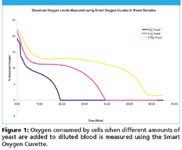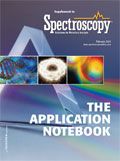Smart Oxygen Cuvette for Optical Monitoring of Dissolved Oxygen in Biological Blood Samples
A "Smart" Oxygen Cuvette has been developed by coating the inner surface of a plastic (PMMA) cuvette with sol-gel based oxygen-sensitive indicator material.
Harish Dabhi and Mahmoud R. Shahriari, Ocean Optics, Inc.
Different methods have been in existence to detect the presence of microorganisms in blood cultures. Early detection of such organisms is of primary importance to the selection of appropriate therapies and doses to be adopted for patients. The information collected using such methods helps in the selection of system parameters optimum for detection of the different microorganisms. Some of the changes such as conversion of oxy- to deoxyghemoglobin within the red blood cells have been detected using spectroscopy methods, which provide data on growth behavior of organisms. In this application note, we explain how a cuvette coated with an oxygen-sensitive indicator acts as a detection system to measure the dissolved partial pressure of oxygen in blood culture systems. We also show the trend in oxygen consumption in response to the increasing density of yeast microorganisms in the blood samples.
Experimental Conditions
The oxygen sensing experiment was carried out using a Smart Oxygen Cuvette. We started our experiment by placing whole goat blood and water in the cuvette. Data logging began at the instant diluted low-level oxygenated blood was placed in the cuvette. Once the oxygen levels were stable, yeast cells were added to the blood in the cuvette. The oxygen quenching was observed over a period of time. After each run all of the dissolved oxygen sensor data was logged. The experiment was conducted three times.
Results
The system was calibrated and the dissolved oxygen levels were monitored when the yeast cells were added and the measurements carried out for approximately 30 min. With an objective to study the performance of the Smart Cuvette while sensing oxygen levels in the cell culture, we performed a set of experiments varying the amount of yeast dissolved in blood. The oxygen is consumed by the cells faster if the number of cells is greater. Figure 1 shows the performance of the Smart Oxygen Cuvette in measuring the dissolved oxygen levels in cell culture environment with different yeast amounts added to diluted blood.

Figure 1
Conclusions
A Smart Oxygen cuvette is reported to provide superior measurements of dissolved oxygen in important biological experiments such as in blood culture/bioreactor systems. The integration of Smart Oxygen Cuvettes with advanced phase fluorometry can be used to develop portable systems to measure the presence of bacteria in different blood cultures. Development of a cost effective system integrated with multiplexing capabilities would open a new approach to studying the presence of microorganisms in blood culture systems. Systems of this nature could accelerate intervention procedures and help reduce healthcare costs.
References
(1) Brindley, P. G., N. Zhu and W. Sligl, "Best Evidence in Critical Care Medicine - Early Antibiotics and Survival from Septic Shock: It's about Time," Can. J. Anaesth. 53, 1157–1160 (2006).
(2) Debra E. Huffman, et al, "New method for the detection of micro-organisms in blood: application of quantitative interpretation model to aerobic blood cultures," J. Biomed. Opt. 14, 034043 (2009), DOI:10.1117/1.3156837.

Ocean Optics, Inc.
830 Douglas Ave., Dunedin, FL 34698
tel. (727) 733-2447; fax (727) 733-3962
Website: www.oceanoptics.com; Email: info@oceanoptics.com

Thermo Fisher Scientists Highlight the Latest Advances in Process Monitoring with Raman Spectroscopy
April 1st 2025In this exclusive Spectroscopy interview, John Richmond and Tom Dearing of Thermo Fisher Scientific discuss the company’s Raman technology and the latest trends for process monitoring across various applications.
A Seamless Trace Elemental Analysis Prescription for Quality Pharmaceuticals
March 31st 2025Quality assurance and quality control (QA/QC) are essential in pharmaceutical manufacturing to ensure compliance with standards like United States Pharmacopoeia <232> and ICH Q3D, as well as FDA regulations. Reliable and user-friendly testing solutions help QA/QC labs deliver precise trace elemental analyses while meeting throughput demands and data security requirements.